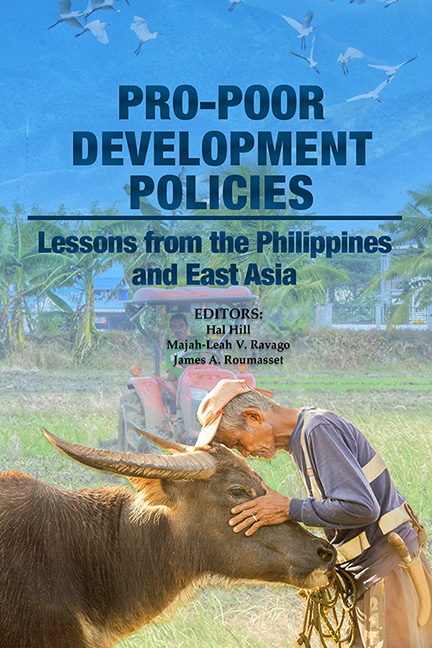Book contents
- Frontmatter
- Dedication
- Contents
- Figures, Tables and Boxes
- Foreword
- Foreword
- Message
- Preface and Acknowledgements
- About the Editors
- About the Contributors
- Acronyms
- Part 1 Introduction and Synthesis
- Part 2 Agricultural and Economic Development
- Part 3 Economic Policies for Achieving Targeted Levels of Living in the Philippines
- Part 4 Inequality and Economic Development
- Part 5 Competition Law and Policy
- Part 6 International Dimensions
- Index
2 - Philippine Economic Development in Comparative Perspective: An Interpretative Essay
Published online by Cambridge University Press: 09 January 2024
- Frontmatter
- Dedication
- Contents
- Figures, Tables and Boxes
- Foreword
- Foreword
- Message
- Preface and Acknowledgements
- About the Editors
- About the Contributors
- Acronyms
- Part 1 Introduction and Synthesis
- Part 2 Agricultural and Economic Development
- Part 3 Economic Policies for Achieving Targeted Levels of Living in the Philippines
- Part 4 Inequality and Economic Development
- Part 5 Competition Law and Policy
- Part 6 International Dimensions
- Index
Summary
INTRODUCTION
The Philippine economy has often been characterized as a laggard, an “East Asian exception”, and a “Latin American economy in East Asia”. The forward-looking Asian Development Bank (ADB) publication, Asia 2050, (ADB 2011) classifies the country with the region’s slower growing economies, including Afghanistan, Nepal, Myanmar and North Korea. But as the eminent Filipino economist Felipe Medalla has observed, the Philippines is an “average” economy, in the sense that its long-term economic performance is similar to the global average. Over the period 1960–2018, for example, the country’s per capita gross domestic product (GDP) in real terms rose 2.9 times, exactly the same as that for the world as a whole. In other words, it is its deviation from the record of some very dynamic Asian economies that is distinctive; in global terms, its performance is not unusual.
Importantly, these averages conceal a great deal of variation over time. Most countries have episodes of faster and slower growth, booms and busts. This is certainly the case for the post-independence Philippine economy. In fact, in this paper we argue that three more or less distinct periods are observable. Although the periods are not precise, they are approximately:
1. From independence (1946) to the late 1970s: high initial expectations, slowing growth
2. From the late 1970s to the early 1990s: growing into a deep and extended crisis
3. From the early 1990s to 2019: recovery, rejoining the East Asian economic mainstream
To these may now be added the current period, 2020–21, of the COVID-19 pandemic-induced health and economic crisis, which introduces a sharp discontinuity into our analysis.
There are therefore periods of both modest and quite strong economic growth, together with two major crisis episodes—the macroeconomic and political crisis of 1984–86 and its aftermath, and the COVID-19 pandemic of 2020–21. Note also that the three main economic episodes correspond loosely, but not exactly, to the country’s political periods—that is, the democratic eras of 1946–72 and after 1986, and the authoritarian era of 1972–86, of Martial Law and its aftermath.
It is instructive to examine these episodes and draw inferences from them.
- Type
- Chapter
- Information
- Pro-poor Development PoliciesLessons from the Philippines and East Asia, pp. 29 - 72Publisher: ISEAS–Yusof Ishak InstitutePrint publication year: 2022

